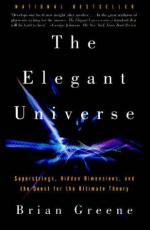
|
| Name: _________________________ | Period: ___________________ |
This quiz consists of 5 multiple choice and 5 short answer questions through Chapter 6, Nothing but Music, The Essentials of Superstring Theory.
Multiple Choice Questions
1. Which of the following is closest to the Planck length?
(a) A thousandth of a centimeter.
(b) A millionth of a billionth of a billionth of a billionth of a centimeter.
(c) A billionth of a billionth of a centimeter.
(d) A millionth of a centimeter.
2. Quantum electroweak theory concerns quantum mechanics and _____.
(a) Gravity.
(b) The weak force.
(c) The strong force.
(d) The electromagnetic force.
3. In quantum mechanics, what is symmetry breaking?
(a) When an asymmetrical matter and anti-matter pair is created.
(b) When two fused fundamental forces become separated out.
(c) When the symmetry between a electrical and magnetic field is broken at high energy levels.
(d) The primary reason that the theory is incompatible with general relativity.
4. What is the fundamental particle, the smallest possible bundle of energy, for the electromagnetic force?
(a) The electron.
(b) The photon.
(c) The gluon.
(d) The neutrino.
5. The wave-like nature of the electron means that after a collision, _____.
(a) The electron will double in frequency.
(b) The electron can never be located again.
(c) The electron will disperse into a wave of energy.
(d) The electron has a range of possible locations.
Short Answer Questions
1. What is the photoelectric effect?
2. How are the amplitude of a string's vibration and the mass of the particle it represents related?
3. What is the quantum, or messenger particle, of gravity?
4. What type of motion cannot be felt or sensed by the moving observer?
5. What is quantum foam?
|
This section contains 354 words (approx. 2 pages at 300 words per page) |

|




